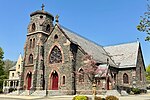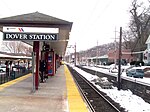Wharton, New Jersey

Wharton is a borough in Morris County, in the U.S. state of New Jersey. As of the 2020 United States census, the borough's population was 7,241, an increase of 719 (+11.0%) from the 2010 census count of 6,522, which in turn reflected an increase of 224 (+3.6%) from the 6,298 counted in the 2000 census.Wharton was originally incorporated as the borough Port Oram by an act of the New Jersey Legislature on June 26, 1895, created from portions of Randolph Township and Rockaway Township, subject to the results of a referendum passed on the previous day; the name was changed to Wharton on April 16, 1902, based on a referendum held that day and subject to legislation passed on March 27, 1902. The borough was named for Joseph Wharton of the Wharton Steel Company.
Excerpt from the Wikipedia article Wharton, New Jersey (License: CC BY-SA 3.0, Authors, Images).Wharton, New Jersey
Lafayette Street,
Geographical coordinates (GPS) Address Nearby Places Show on map
Geographical coordinates (GPS)
| Latitude | Longitude |
|---|---|
| N 40.897055 ° | E -74.574512 ° |
Address
Lafayette Street
07885
New Jersey, United States
Open on Google Maps





